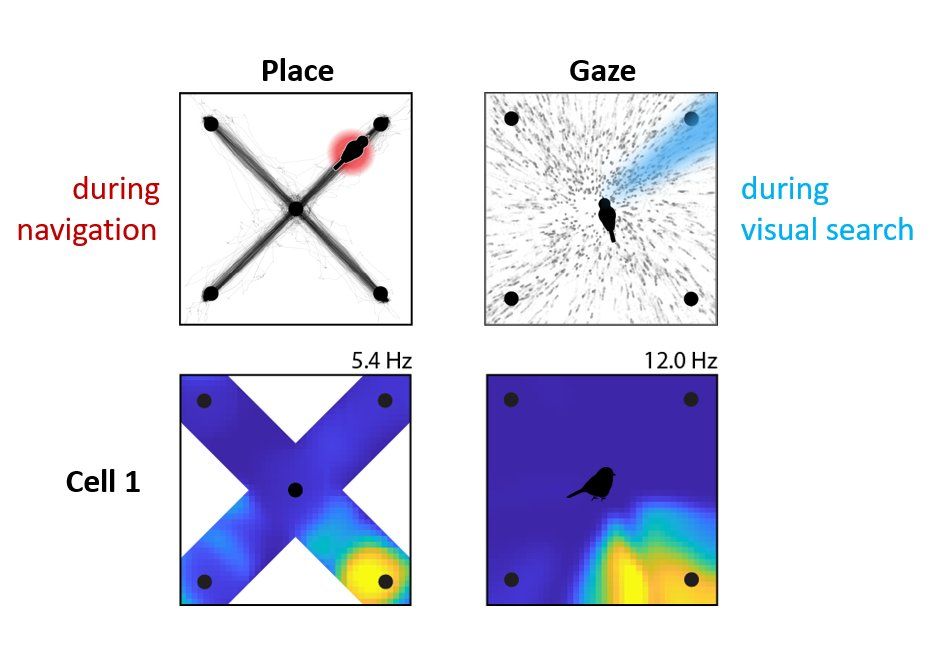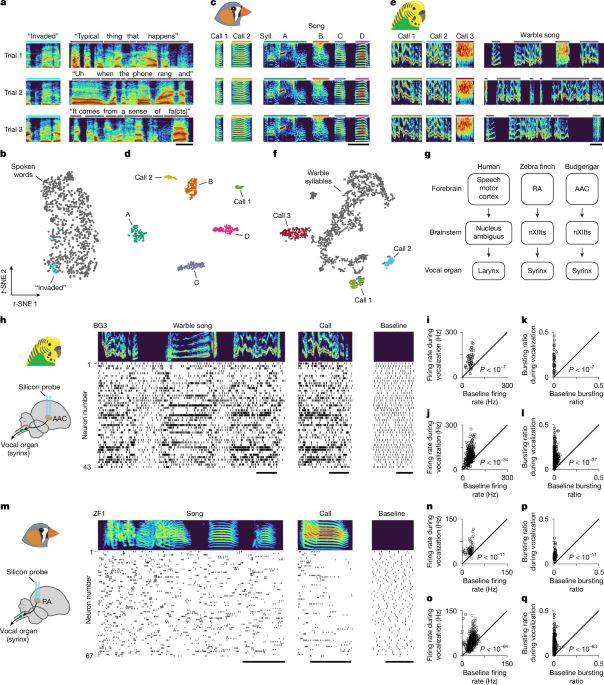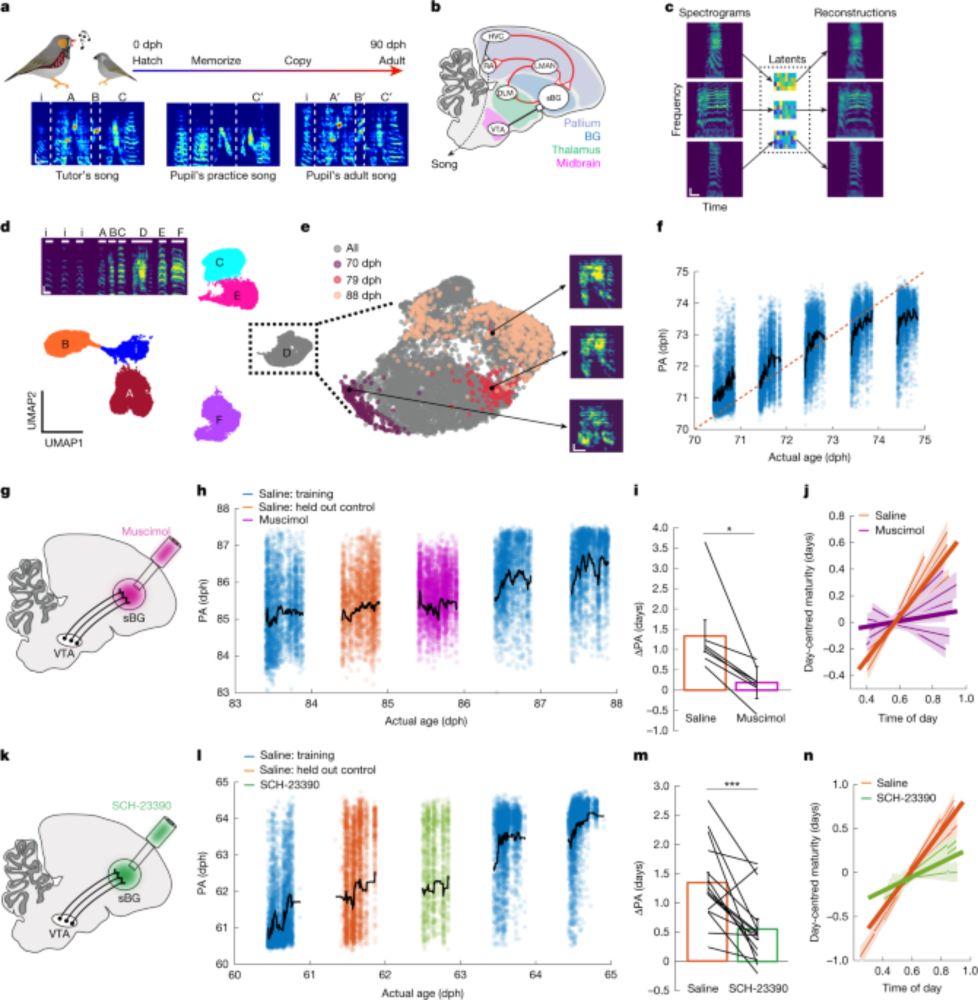
Felix W. Moll
@mollfw.bsky.social
Research Group Leader at the Institute of Neurobiology, University of Tübingen. Neuroscientist. Studies crows and modern dinosaur brains 🦖 --> 🐦⬛.
Group website: felixmoll.com
Group website: felixmoll.com
Pinned
Felix W. Moll
@mollfw.bsky.social
· Sep 11

New paper on precise tool use learning in carrion crows @currentbiology.bsky.social. We show that—like New Caledonian crows—expert carrion crows pay close attention to the working end of their tool, suggesting tool integration into their peripersonal space. 🧵 & vids! 👇
www.cell.com/current-biol...
www.cell.com/current-biol...
Reposted by Felix W. Moll
Researchers gave female canaries testosterone, which causes them to sing. Two-photon in vivo imaging reveals that songs emerge due to changes in brain cell function rather than by increasing the size of a key brain region, as was once thought. In PNAS: https://ow.ly/pn1750XhFL5

October 24, 2025 at 4:03 PM
Researchers gave female canaries testosterone, which causes them to sing. Two-photon in vivo imaging reveals that songs emerge due to changes in brain cell function rather than by increasing the size of a key brain region, as was once thought. In PNAS: https://ow.ly/pn1750XhFL5
Great Dispatch piece by @milliejohnston.bsky.social et al.. Our crows are very flattered: "Great skill can be found in the dextrous movements of a tool tip. [ ] from cave paintings and papyrus scripts to Da Vinci’s sketches and today’s remote laparoscopic surgery."
www.cell.com/current-biol...
www.cell.com/current-biol...

Animal tool use: Capturing tool-expertise development with a deep learning network
Movement tracking using the deep-learning network DeepLabCut has revealed how a species
not known for tool use acquires and refines tool skills. This opens the door to detailed
cross-species compariso...
www.cell.com
October 21, 2025 at 12:17 PM
Great Dispatch piece by @milliejohnston.bsky.social et al.. Our crows are very flattered: "Great skill can be found in the dextrous movements of a tool tip. [ ] from cave paintings and papyrus scripts to Da Vinci’s sketches and today’s remote laparoscopic surgery."
www.cell.com/current-biol...
www.cell.com/current-biol...
Reposted by Felix W. Moll
🐦 21 species all produce similar whining noises towards their brood parasites
🐦 Found in areas w/dense parasite-host networks
🐦 Playbacks trigger innate recruit response from all hosts
🐦 --> intermediate b/t innate & learned signals!
www.nature.com/articles/s41...
#prattle 💬
#bioacoustics
2/2
🐦 Found in areas w/dense parasite-host networks
🐦 Playbacks trigger innate recruit response from all hosts
🐦 --> intermediate b/t innate & learned signals!
www.nature.com/articles/s41...
#prattle 💬
#bioacoustics
2/2

Learned use of an innate sound-meaning association in birds - Nature Ecology & Evolution
Over 20 species of geographically and phylogenetically diverse bird species produce convergent whining vocalizations towards their respective brood parasites. Model presentation and playback experimen...
www.nature.com
October 15, 2025 at 1:19 PM
🐦 21 species all produce similar whining noises towards their brood parasites
🐦 Found in areas w/dense parasite-host networks
🐦 Playbacks trigger innate recruit response from all hosts
🐦 --> intermediate b/t innate & learned signals!
www.nature.com/articles/s41...
#prattle 💬
#bioacoustics
2/2
🐦 Found in areas w/dense parasite-host networks
🐦 Playbacks trigger innate recruit response from all hosts
🐦 --> intermediate b/t innate & learned signals!
www.nature.com/articles/s41...
#prattle 💬
#bioacoustics
2/2
Reposted by Felix W. Moll
A 2024 study found that ants best humans at tests of collective intelligence.
Learn more on #WorldAnimalDay: https://scim.ag/42nMvQJ
Learn more on #WorldAnimalDay: https://scim.ag/42nMvQJ
October 4, 2025 at 6:19 PM
A 2024 study found that ants best humans at tests of collective intelligence.
Learn more on #WorldAnimalDay: https://scim.ag/42nMvQJ
Learn more on #WorldAnimalDay: https://scim.ag/42nMvQJ
Reposted by Felix W. Moll
🌆🐀Scientific American article about the project we're starting on NYC rats!! scientificamerican.com/article/scie...
w/ Emily Mackevicius, Dima Batenkov, @zamakany.bsky.social, @basisresearch.bsky.social
Seeking collaborators and funders 🐀🌆
w/ Emily Mackevicius, Dima Batenkov, @zamakany.bsky.social, @basisresearch.bsky.social
Seeking collaborators and funders 🐀🌆

New York City’s Rats Have a Secret Nightlife—And a Language Humans Can’t Hear
A new preprint field study reveals that New York City’s rats aren’t just survivors—they’re talkative city dwellers with their own hidden nightlife. Mapping their movements and conversations could offe...
scientificamerican.com
September 15, 2025 at 12:33 PM
🌆🐀Scientific American article about the project we're starting on NYC rats!! scientificamerican.com/article/scie...
w/ Emily Mackevicius, Dima Batenkov, @zamakany.bsky.social, @basisresearch.bsky.social
Seeking collaborators and funders 🐀🌆
w/ Emily Mackevicius, Dima Batenkov, @zamakany.bsky.social, @basisresearch.bsky.social
Seeking collaborators and funders 🐀🌆
Reposted by Felix W. Moll
Ein Forschungsteam der @unituebingen.bsky.social zeigt, wie Krähen lernen, ein Stäbchen präzise im Schnabel zu führen, um damit an Futter zu gelangen: 👉 uni-tuebingen.de/universitaet... #Neurobiologie #Biologie #Forschung

September 11, 2025 at 12:14 PM
Ein Forschungsteam der @unituebingen.bsky.social zeigt, wie Krähen lernen, ein Stäbchen präzise im Schnabel zu führen, um damit an Futter zu gelangen: 👉 uni-tuebingen.de/universitaet... #Neurobiologie #Biologie #Forschung
New paper on precise tool use learning in carrion crows @currentbiology.bsky.social. We show that—like New Caledonian crows—expert carrion crows pay close attention to the working end of their tool, suggesting tool integration into their peripersonal space. 🧵 & vids! 👇
www.cell.com/current-biol...
www.cell.com/current-biol...

September 11, 2025 at 10:15 AM
New paper on precise tool use learning in carrion crows @currentbiology.bsky.social. We show that—like New Caledonian crows—expert carrion crows pay close attention to the working end of their tool, suggesting tool integration into their peripersonal space. 🧵 & vids! 👇
www.cell.com/current-biol...
www.cell.com/current-biol...
Cool new paper on how neurons in my favorite bird's brain encode time. Congrats Millie and Max!! @milliejohnston.bsky.social , @crowbrain.bsky.social
I'm delighted to share that, together with @crowbrain.bsky.social our paper on time estimation in crows is now published in @natcomms.nature.com
We found that crows not only keep track of time, but individual neurons prefer different time durations 🐦⏱️🧠
Check it out:
www.nature.com/articles/s41...
We found that crows not only keep track of time, but individual neurons prefer different time durations 🐦⏱️🧠
Check it out:
www.nature.com/articles/s41...

A neuronal correlate for time interval estimation in the crow’s telencephalon - Nature Communications
It is unknown how birds estimate time using brains organized differently from mammals. Here, the authors show that neurons in the crow NCL encode duration categories, supporting abstract, cue-independ...
www.nature.com
September 11, 2025 at 8:44 AM
Cool new paper on how neurons in my favorite bird's brain encode time. Congrats Millie and Max!! @milliejohnston.bsky.social , @crowbrain.bsky.social
Cool new method (functional ultrasound imaging) now established in the crow by @daliao.bsky.social and colleagues:
www.jneurosci.org/content/45/2...
www.jneurosci.org/content/45/2...

Exploring Neural Dynamics in the Auditory Telencephalon of Crows Using Functional Ultrasound Imaging
Crows, renowned for advanced cognitive abilities and vocal communication, rely on intricate auditory systems. While the neuroanatomy of corvid auditory pathways is partially explored, the underlying n...
www.jneurosci.org
July 17, 2025 at 7:45 AM
Cool new method (functional ultrasound imaging) now established in the crow by @daliao.bsky.social and colleagues:
www.jneurosci.org/content/45/2...
www.jneurosci.org/content/45/2...
Amazing meeting with amazing people!
Birdsong, brains & sunshine! More than 70 brilliant minds from across the globe flocked to Seewiesen to get inspired by cutting-edge research. From finches to singing mice, vocal research flew high at the European Birdsong Meeting hosted at our Institute.

June 14, 2025 at 9:06 AM
Amazing meeting with amazing people!
Reposted by Felix W. Moll
Our paper on brain size evolution in birds of paradise was recently accepted!
In brief:
•BoPs have big brains, comparable to those of medium-sized corvids
•Neither absolute nor relative brain size appears to have co-evolved with display complexity
doi.org/10.1093/orni...
In brief:
•BoPs have big brains, comparable to those of medium-sized corvids
•Neither absolute nor relative brain size appears to have co-evolved with display complexity
doi.org/10.1093/orni...

Did complex song and dance co-evolve with brain size in the birds-of-paradise (Aves: Paradisaeidae)?
Abstract. Complex signaling behaviors, such as avian song and courtship displays, have been associated with increases in both absolute and relative brain s
doi.org
June 6, 2025 at 9:39 PM
Our paper on brain size evolution in birds of paradise was recently accepted!
In brief:
•BoPs have big brains, comparable to those of medium-sized corvids
•Neither absolute nor relative brain size appears to have co-evolved with display complexity
doi.org/10.1093/orni...
In brief:
•BoPs have big brains, comparable to those of medium-sized corvids
•Neither absolute nor relative brain size appears to have co-evolved with display complexity
doi.org/10.1093/orni...
Reposted by Felix W. Moll
My latest Aronov lab paper is now published @Nature!
When a chickadee looks at a distant location, the same place cells activate as if it were actually there 👁️
The hippocampus encodes where the bird is looking, AND what it expects to see next -- enabling spatial reasoning from afar
bit.ly/3HvWSum
When a chickadee looks at a distant location, the same place cells activate as if it were actually there 👁️
The hippocampus encodes where the bird is looking, AND what it expects to see next -- enabling spatial reasoning from afar
bit.ly/3HvWSum

June 11, 2025 at 10:24 PM
My latest Aronov lab paper is now published @Nature!
When a chickadee looks at a distant location, the same place cells activate as if it were actually there 👁️
The hippocampus encodes where the bird is looking, AND what it expects to see next -- enabling spatial reasoning from afar
bit.ly/3HvWSum
When a chickadee looks at a distant location, the same place cells activate as if it were actually there 👁️
The hippocampus encodes where the bird is looking, AND what it expects to see next -- enabling spatial reasoning from afar
bit.ly/3HvWSum
Reposted by Felix W. Moll
Our first look at midbrain PAG’s role in singing mouse vocal control. When near each other, these mice produce two divergent vocal modes. Same circuits for USVs and Songs—or different ones? Bets were made..some of us bought beers for others! Led by @xmikezheng20.bsky.social & Clifford Harpole. 👇🏽
Important new work from @xmikezheng20.bsky.social @arkarupbanerjee.bsky.social et al
bit.ly/42dWcQN
ethology+modeling+targeted neural manipulation —> new textbook example of how evolutionary tinkering can generate multiple behavioral modes with a single neural circuit
#bioacoustics
#prattle 💬
bit.ly/42dWcQN
ethology+modeling+targeted neural manipulation —> new textbook example of how evolutionary tinkering can generate multiple behavioral modes with a single neural circuit
#bioacoustics
#prattle 💬

Parametric Modulation of a Shared Midbrain Circuit Drives Distinct Vocal Modes in a Singing Mouse
Neural circuits capable of generating multiple outputs are essential for behavioral flexibility, yet their organizational principles remain poorly understood. Using vocal communication in singing mice...
bit.ly
April 6, 2025 at 2:08 AM
Our first look at midbrain PAG’s role in singing mouse vocal control. When near each other, these mice produce two divergent vocal modes. Same circuits for USVs and Songs—or different ones? Bets were made..some of us bought beers for others! Led by @xmikezheng20.bsky.social & Clifford Harpole. 👇🏽
Reposted by Felix W. Moll
Nature research paper: Convergent vocal representations in parrot and human forebrain motor networks
https://go.nature.com/4iEIBsz
https://go.nature.com/4iEIBsz

Convergent vocal representations in parrot and human forebrain motor networks - Nature
Using advanced brain-recording techniques, parrots were found to have a brain organization for vocal control similar to humans, making them an important model for studying speech and for developing potential treatments for communication disorders.
go.nature.com
March 19, 2025 at 4:30 PM
Nature research paper: Convergent vocal representations in parrot and human forebrain motor networks
https://go.nature.com/4iEIBsz
https://go.nature.com/4iEIBsz
Reposted by Felix W. Moll
Proud to have contributed to @jiaxuanqi.bsky.social's masterpiece out @nature.com! She shows that dopamine transients track the learned quality of song during juvenile learning and that dopamine release is driven not just by VTA firing, but by a local cholinergic mechanism! (1/x)

Dual neuromodulatory dynamics underlie birdsong learning - Nature
Dopamine release in the basal ganglia of the zebra finch is driven by neurons associated with reinforcement learning and by cholinergic signalling, and tracks performance quality during long-term lear...
www.nature.com
March 12, 2025 at 4:54 PM
Proud to have contributed to @jiaxuanqi.bsky.social's masterpiece out @nature.com! She shows that dopamine transients track the learned quality of song during juvenile learning and that dopamine release is driven not just by VTA firing, but by a local cholinergic mechanism! (1/x)
Reposted by Felix W. Moll
Excited to share our latest work! It’s been a great experience working on this (including building a whole new lab!) 😊
www.nature.com/articles/s41...
www.nature.com/articles/s41...

Natural behaviour is learned through dopamine-mediated reinforcement - Nature
Studies in zebra finches show that dopamine has a key role as a reinforcement signal in the trial-and-error process of learning that underlies complex natural behaviours.
www.nature.com
March 12, 2025 at 5:11 PM
Excited to share our latest work! It’s been a great experience working on this (including building a whole new lab!) 😊
www.nature.com/articles/s41...
www.nature.com/articles/s41...
Now published in JCN: "Exploring Anatomical Links Between the Crow's Nidopallium Caudolaterale and Its Song System"
In crows (which are songbirds!), we show that the song system is paralleled by the 'general motor system' (cf. Feenders, 2008; Farries, 2001).
onlinelibrary.wiley.com/doi/full/10....
In crows (which are songbirds!), we show that the song system is paralleled by the 'general motor system' (cf. Feenders, 2008; Farries, 2001).
onlinelibrary.wiley.com/doi/full/10....

Exploring Anatomical Links Between the Crow's Nidopallium Caudolaterale and Its Song System
The crow's nidopallium caudolaterale (NCL) projects densely to the dorsal intermediate arcopallium (AID) and the striatum, paralleling important song system pathways. Connections from the magnocellul...
onlinelibrary.wiley.com
February 10, 2025 at 8:56 AM
Now published in JCN: "Exploring Anatomical Links Between the Crow's Nidopallium Caudolaterale and Its Song System"
In crows (which are songbirds!), we show that the song system is paralleled by the 'general motor system' (cf. Feenders, 2008; Farries, 2001).
onlinelibrary.wiley.com/doi/full/10....
In crows (which are songbirds!), we show that the song system is paralleled by the 'general motor system' (cf. Feenders, 2008; Farries, 2001).
onlinelibrary.wiley.com/doi/full/10....

